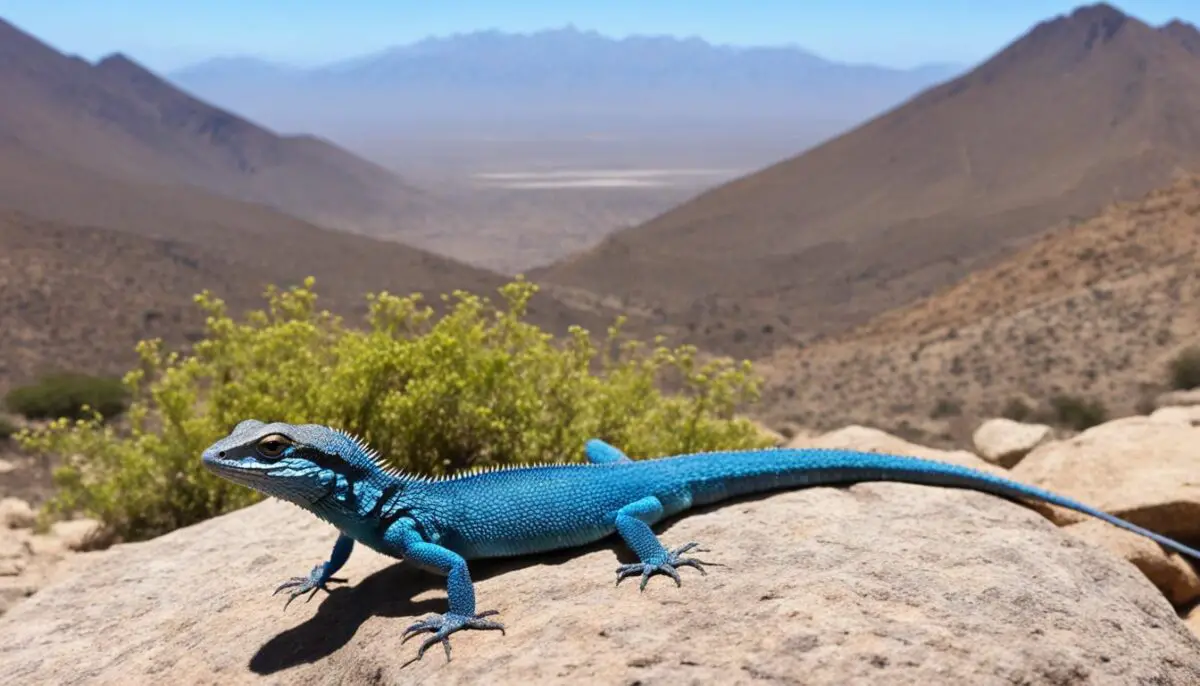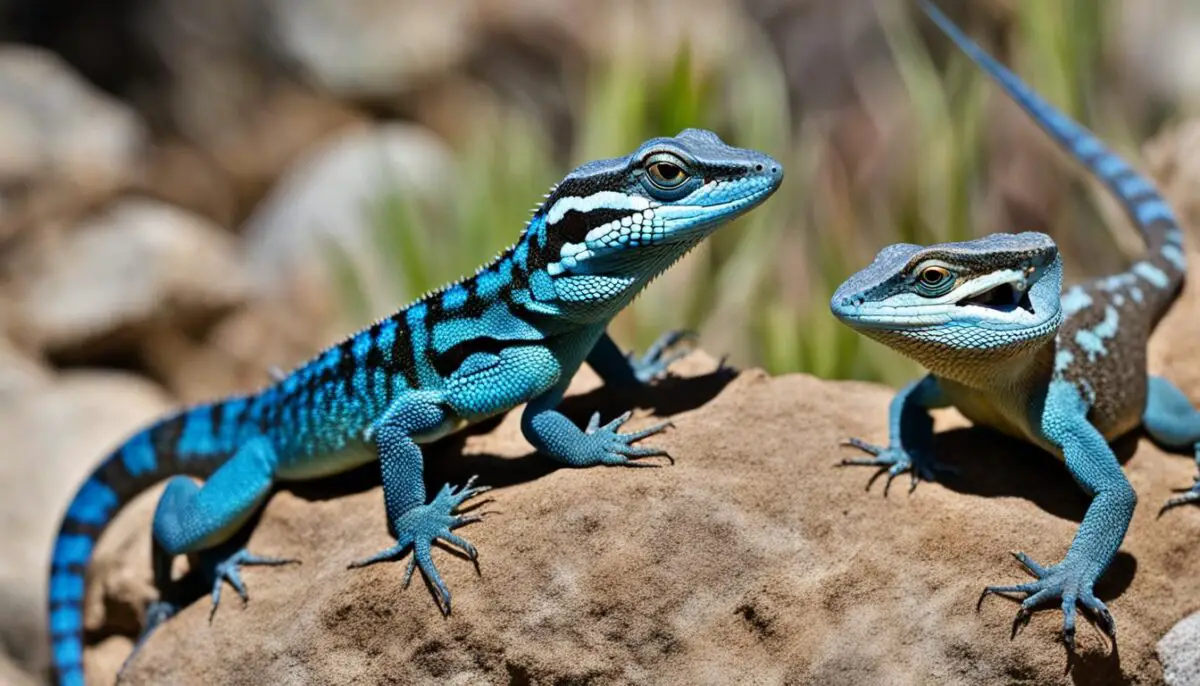The Blue Belly Lizard, also known as the Western Fence Lizard, is a fascinating reptile species found in California and other Western states. With its distinctive bright blue ventral abdomen, this lizard stands out among California’s diverse reptile populations. Let’s explore some interesting facts and details about this native lizard!
Key Takeaways:
- The Blue Belly Lizard, also known as the Western Fence Lizard, is a reptile species native to California and other Western states.
- It is characterized by its vibrant blue ventral abdomen, which gives it its nickname.
- The Western Fence Lizard can be found in various habitats, including grasslands, chaparral, sagebrush, woodlands, and forests.
- These lizards are diurnal creatures and are commonly seen basking in the sun.
- They primarily feed on small invertebrates like spiders, beetles, mosquitoes, and grasshoppers.
Taxonomy and Subspecies
The western fence lizard, scientifically known as Sceloporus occidentalis, belongs to the genus Sceloporus and the species occidentalis. Within this species, multiple subspecies have been identified, each with its own unique characteristics and distribution range within California.
The subspecies of the western fence lizard native to California include:
- San Joaquin fence lizard
- Coast Range fence lizard
- Great Basin fence lizard
- Northwestern fence lizard
- Sierra fence lizard
These different subspecies can be distinguished based on variations in physical traits, such as coloration and scale patterns, as well as their specific habitats and geographical ranges within California.
“The western fence lizard is a complex group of lizards with multiple recognized subspecies, each with its own unique characteristics and distribution range.” – Alexander Smith, Herpetologist
The taxonomic classification of the western fence lizard has been the subject of debate among experts. While some literature classifies them within the family Phrynosomatidae, recent studies suggest their placement within the family Iguanidae. Further research is ongoing to resolve these taxonomic uncertainties.
Understanding the taxonomy and subspecies of the western fence lizard helps researchers and enthusiasts gain insights into the evolutionary history and ecological diversity of this native lizard species in California.

The Subspecies of Western Fence Lizard in California
| Subspecies | Characteristics | Distribution Range |
|---|---|---|
| San Joaquin fence lizard | Distinct coloring on dorsal surface; longer and more slender body | Central Valley and surrounding areas |
| Coast Range fence lizard | Grey or brown coloration; shorter and stockier body | Coastal regions and foothills |
| Great Basin fence lizard | Light gray or tan coloration; prominent black stripes on back | Eastern Sierra Nevada and Great Basin |
| Northwestern fence lizard | Light brown or olive coloration; irregular black stripes on back | Northwestern coastal areas and forests |
| Sierra fence lizard | Brown coloration with lighter markings on back; prominent blue belly | Sierra Nevada mountain range |
Identification and Appearance
The western fence lizard is easily identifiable due to its distinct physical features. Adult lizards typically measure around 5.7 to 8.9 centimeters in length, with a total length of about 21 centimeters. They have a coloration that ranges from brown to black, adorned with prominent black stripes along their backs.
However, what truly sets them apart is their vibrant blue ventral abdomen, which has earned them the nickname “blue belly lizard.” Males, in particular, exhibit additional blue patches on their throats and may even display iridescent turquoise spots on their dorsal surface, enhancing their mesmerizing appearance.
Although females and juveniles possess less pronounced blue coloration, they still exhibit the characteristic bright blue belly. The scales of western fence lizards are sharply keeled, and they typically have 35 to 57 scales between the interparietal and rear of their thighs, further contributing to their unique appearance.

Western Fence Lizard Distribution
| State | Presence |
|---|---|
| California | Most prevalent |
| Arizona | Present |
| Idaho | Present |
| Nevada | Present |
| Oregon | Present |
| Utah | Present |
| Washington | Present |
| Mexico (Northern) | Present |
As you can see from the table, the western fence lizard has a wide distribution range, contributing to the diverse reptile population in California and other Western states.
Behavior and Diet
Western fence lizards, also known as blue belly lizards, are fascinating creatures with unique behaviors and dietary preferences. They are diurnal reptiles, meaning they are active during the day, and can often be spotted basking in the sun on paths, rocks, fence posts, and other spots that provide ample sunlight. This behavior allows them to regulate their body temperature, as they can change their color from light gray or tan to nearly jet black, absorbing more heat or reflecting it away.
When it comes to their diet, blue belly lizards primarily feed on small invertebrates. Their menu includes a variety of insects such as spiders, beetles, mosquitoes, and grasshoppers. These agile little hunters use their sharp eyesight and quick reflexes to capture their prey, making them efficient insect control agents in their habitats. By feeding on these small creatures, blue belly lizards play a role in maintaining a healthy ecosystem by controlling insect populations.
During the mating season, adult male blue belly lizards exhibit territorial behavior. They defend their home ranges and engage in combat or displays to establish dominance and attract females. This behavior showcases the competitive nature of these lizards, and their desire to secure the best resources for breeding.
“Blue belly lizards are truly remarkable creatures with their ability to thermoregulate and their role in controlling insect populations. Understanding their behavior and diet provides valuable insights into their survival strategies and their impact on their environment.”
Blue belly lizards are most active during warm temperatures and may seek shelter during extreme heat or cold. This behavior helps them conserve energy and protect themselves from harsh weather conditions. By adapting their behavior to their surroundings, these lizards demonstrate their resilience and ability to thrive in various ecosystems.

The breeding season and reproductive behaviors of blue belly lizards can vary depending on the specific subspecies and geographical location. Factors such as climate, habitat availability, and population density can influence the timing and success of reproduction for these fascinating reptiles.
Conservation Status and Impact
Despite the western fence lizard, also known as the blue belly lizard, being currently listed as “least concern” on the IUCN Red List, its population has been significantly affected by habitat loss caused by urbanization. In urban environments, these lizards have undergone evolutionary changes, adapting to their altered surroundings.
Due to the changes in habitat, lizards in urban areas are observed to have shorter limbs and toes. The increase in temperature from urban heat islands is also known to influence the scale size and number of these lizards.
A fascinating aspect of western fence lizards is their impact on reducing the transmission of Lyme disease. These lizards possess a protein in their blood that kills the bacterium responsible for the disease in ticks, thereby reducing the incidence of Lyme disease in areas where these lizards are present.
| Key Points | Impact |
|---|---|
| Habitat loss caused by urbanization | Affected population distribution and adaptation |
| Evolutionary changes in urban environments | Shorter limbs and toes |
| Influence of urban heat islands | Affects scale size and number |
| Role in reducing Lyme disease transmission | Contains a protein that kills disease-causing bacteria in ticks |
Understanding and addressing the impacts of urbanization on the western fence lizard’s habitat is crucial for the conservation of this unique reptile species in California and other Western states. By preserving their natural habitats and recognizing the significance of their role in mitigating Lyme disease, we can help sustain their population and maintain a balanced ecosystem.
Conclusion
The blue belly lizard, also known as the western fence lizard, is a remarkable reptile species that can be found in California and other Western states. This lizard’s vibrant blue ventral abdomen, coupled with its unique behavior and habitat preferences, make it a fascinating subject for both researchers and lizard enthusiasts. Despite facing challenges such as urbanization and habitat loss, the western fence lizard plays a significant role in maintaining ecosystem health by combatting Lyme disease transmission.
By understanding and appreciating these native lizard species, we can contribute to their conservation efforts and preserve the rich diversity of reptiles in California. The blue belly lizard’s ability to kill the bacterium causing Lyme disease in ticks showcases its importance in reducing the incidence of this illness. As we continue to explore and study these reptiles, we gain valuable insights into their ecology and contribute to the overall preservation of California’s reptile populations.
With its striking appearance and intriguing behaviors, the blue belly lizard captivates our attention and provides valuable insights into the natural world. As we work towards safeguarding their habitats and promoting conservation efforts, we ensure the continued existence of these remarkable reptiles for future generations to admire and learn from.
FAQ
What is the scientific name of the blue belly lizard?
The blue belly lizard is scientifically known as Sceloporus occidentalis.
Why is it called the blue belly lizard?
The blue belly lizard gets its name from the bright blue coloration on its ventral abdomen.
What family does the blue belly lizard belong to?
The blue belly lizard belongs to the family Phrynosomatidae.
Are there different subspecies of the blue belly lizard?
Yes, there are several recognized subspecies of the blue belly lizard, including the San Joaquin fence lizard, Coast Range fence lizard, Great Basin fence lizard, Northwestern fence lizard, and Sierra fence lizard.
How can I identify a blue belly lizard?
Blue belly lizards have brown to black coloration with black stripes on their backs. They have a bright blue ventral abdomen and males may have blue patches on their throats.
Where can I find blue belly lizards?
Blue belly lizards are commonly found in California, but they can also be found in other Western states such as Arizona, Idaho, Nevada, Oregon, Utah, and Washington.
What habitats do blue belly lizards prefer?
Blue belly lizards can be found in a variety of habitats, including grassland, chaparral, sagebrush, woodland, and coniferous forests.
What do blue belly lizards eat?
Blue belly lizards primarily feed on small invertebrates such as spiders, beetles, mosquitoes, and grasshoppers.
How do blue belly lizards reproduce?
Blue belly lizards mate in the spring and females lay one to three clutches of eggs between April and July.
What is the conservation status of the blue belly lizard?
The blue belly lizard is currently listed as least concern on the IUCN Red List, but habitat loss caused by urbanization is a concern.
What role do blue belly lizards play in reducing Lyme disease transmission?
Blue belly lizards have a protein in their blood that kills the bacterium causing Lyme disease in ticks, reducing the incidence of the disease in areas where the lizards are present.


